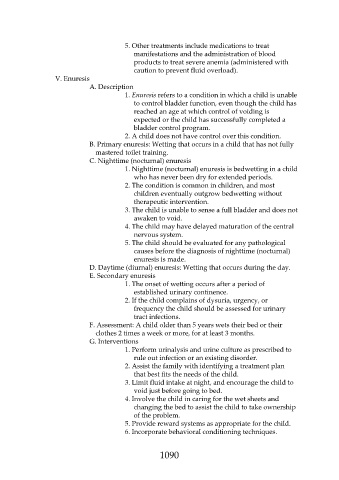Page 1090 - Saunders Comprehensive Review For NCLEX-RN
P. 1090
5. Other treatments include medications to treat
manifestations and the administration of blood
products to treat severe anemia (administered with
caution to prevent fluid overload).
V. Enuresis
A. Description
1. Enuresis refers to a condition in which a child is unable
to control bladder function, even though the child has
reached an age at which control of voiding is
expected or the child has successfully completed a
bladder control program.
2. A child does not have control over this condition.
B. Primary enuresis: Wetting that occurs in a child that has not fully
mastered toilet training.
C. Nighttime (nocturnal) enuresis
1. Nighttime (nocturnal) enuresis is bedwetting in a child
who has never been dry for extended periods.
2. The condition is common in children, and most
children eventually outgrow bedwetting without
therapeutic intervention.
3. The child is unable to sense a full bladder and does not
awaken to void.
4. The child may have delayed maturation of the central
nervous system.
5. The child should be evaluated for any pathological
causes before the diagnosis of nighttime (nocturnal)
enuresis is made.
D. Daytime (diurnal) enuresis: Wetting that occurs during the day.
E. Secondary enuresis
1. The onset of wetting occurs after a period of
established urinary continence.
2. If the child complains of dysuria, urgency, or
frequency the child should be assessed for urinary
tract infections.
F. Assessment: A child older than 5 years wets their bed or their
clothes 2 times a week or more, for at least 3 months.
G. Interventions
1. Perform urinalysis and urine culture as prescribed to
rule out infection or an existing disorder.
2. Assist the family with identifying a treatment plan
that best fits the needs of the child.
3. Limit fluid intake at night, and encourage the child to
void just before going to bed.
4. Involve the child in caring for the wet sheets and
changing the bed to assist the child to take ownership
of the problem.
5. Provide reward systems as appropriate for the child.
6. Incorporate behavioral conditioning techniques.
1090

